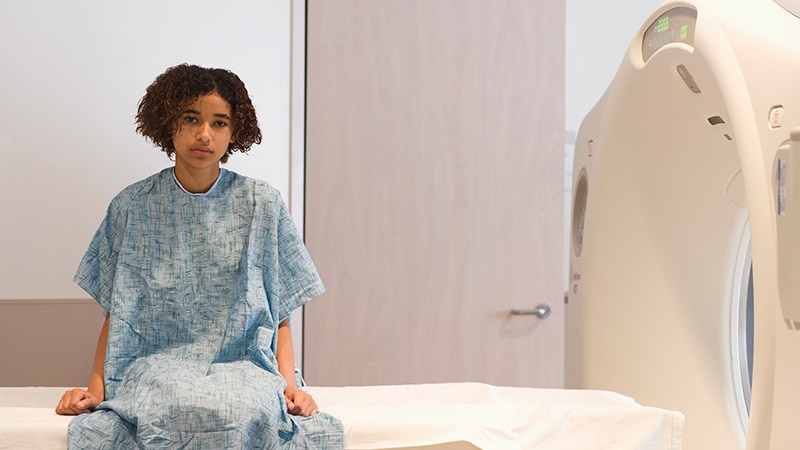White children are more likely to receive diagnostic imaging during emergency department (ED) visits than Black and Hispanic children, according to an analysis of nearly 40 children’s hospitals nationwide. Researchers also found that these racial differences in overall imaging were more pronounced at hospitals that served a higher percentage of minority groups.
The findings highlight “the pervasive presence of structural and individual biases and inequities in care,” write Margaret Samuels-Kalow, MD, an associate professor of emergency medicine and pediatrics at Harvard Medical School in Boston, and colleagues. Samuels-Kalow is also an attending physician in emergency medicine at Massachusetts General Hospital. The findings are “a real call to action” to design systems to eliminate bias and improve equity in imaging for pediatric emergency care, she told Medscape Medical News.
The research was published June 2 in JAMA Network Open.
While racial disparities in pediatric imaging have been documented before, it was not clear what was driving this pattern. Perhaps Black and Hispanic children tend to go to hospitals that conduct less imaging, Samuels-Kalow explained, or maybe children of different races may be treated differently at the same hospital.
To find out, she and her team used the Pediatric Health Information System, a database with clinical and utilization data from 49 children’s hospitals across 27 states and Washington, DC. Of the 38 hospitals included in the analysis, there were 12.3 million ED visits from about 5.9 million children from January 1, 2016, through December 31, 2019. About 36% of visits were from White patients, 28% were from Hispanic patients, and 26% were from Black patients. Patients were, on average, 5 years old. Imaging modalities included radiography, ultrasonography, CT, and MRI. Researchers calculated each hospital’s average imaging rate as well as the racial composition of patients served at that hospital.
During the study period, diagnostic imaging was performed in 34.2% of visits by White patients, 26.1% of visits by Hispanic patients, and 24.6% of visits by Black patients (P < .001). After adjusting for age, sex, ED presentation time, and other relevant confounders, researchers found that Black patients were less likely than White patients to receive any kind of imaging across all hospitals. This pattern was also present for Hispanic patients compared to White patients, though it was less consistent for ultrasonography and MRI. Black patients were also less likely than Hispanic patients to receive imaging across all hospitals, especially ultrasonography.
Hospitals that served a higher percentage of minoritized patients had greater racial disparities in imaging between Black and White children (correlation coefficient, −0.37; 95% CI, −0.62 to −0.07; P = .02).
All hospitals “tended to image Black patients less, and we saw that [this pattern] seemed to be worse at the hospitals that were taking care of higher numbers of Black patients, which is extremely concerning,” Samuels-Kalow said.
This pattern was not found for Hispanic patients compared to either Black or White patients, with one exception: Hispanic patients were less likely to receive an MRI compared to White patients at hospitals that served a larger proportion of minoritized patients (correlation coefficient, −0.43; P = .01).
The average imaging rate of hospitals was not associated with disparities across all imaging, though researchers found that among hospitals with higher imaging rates, racial differences between Black and White patients were more pronounced with regard to radiography (correlation coefficient, 0.41; 95% CI, 0.10 – 0.64; P = .01).
“In adult ED imaging, it’s well documented that there is racial bias when getting radiographic evaluation, whether it’s longer wait times to get your imaging study, or if you get it at all, based on your race,” said Carolynn DeBenedectis, MD, an associate professor of radiology at the University of Massachusetts Chan Medical School in Worcester, Massachusetts, in an interview with Medscape. She was not involved with the study. “In children, the data hasn’t been this straightforward.” For example, a 2015 study found that low health literacy of caregivers played a larger role than race in determining whether children received radiographic testing.
But these new findings help identify racial bias as a factor of imaging disparities, she noted. “This is a much larger study that is showing that, even in children, we’re seeing disparate imaging in emergency departments,” DeBenedectis said. “And it’s based on bias, which I think shows a bigger systemic problem.”
Data analyses should be conducted at individual hospitals and care systems in order to identify gaps in imaging care and potentially produce regular reports as a “real-time feedback system” to track progress, said Efren Flores, MD, a thoracic radiologist and associate chair of equity, inclusion, and community health at Mass General Brigham Radiology, Boston. He also was not involved with the research. “The first step of addressing any barriers to care is gaining a deeper understanding of the issue at hand” and then using that knowledge to guide interventions, he said.
Interventions could include developing standardized care algorithms and pathways for clinicians to follow to avoid variability in imaging, Flores and DeBenedectis agree. Continuing to track imaging utilization for patients with similar clinical presentations — and their health outcomes — can also help clinicians understand how access to imaging affects care, Flores said. “ED setting takes all patients and is uniquely positioned to drive equity and improve outcomes for all patients,” he noted.
DeBenedectis is a paid lecturer on breast imaging for MRI Online. Flores co-chairs the Health Equity Committee of the Radiology Society of North America (RSNA). Samuels-Kalow reported no relevant financial relationships.
JAMA Netw Open. Published online June 2, 2022. Full text
For more news, follow Medscape on Facebook, Twitter, Instagram, and YouTube.
Source: Read Full Article
